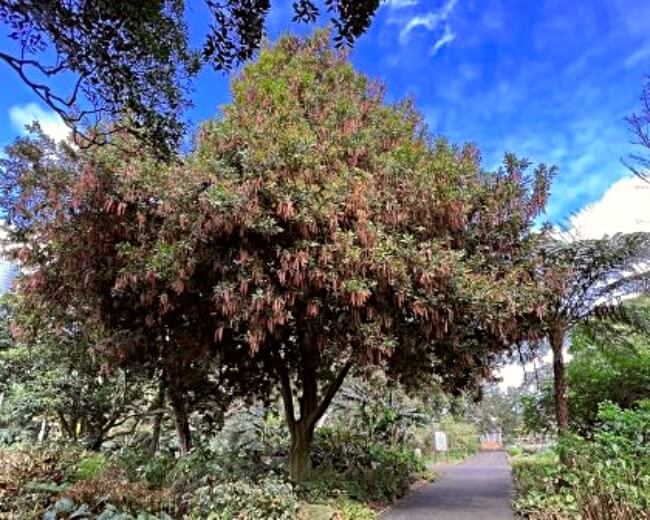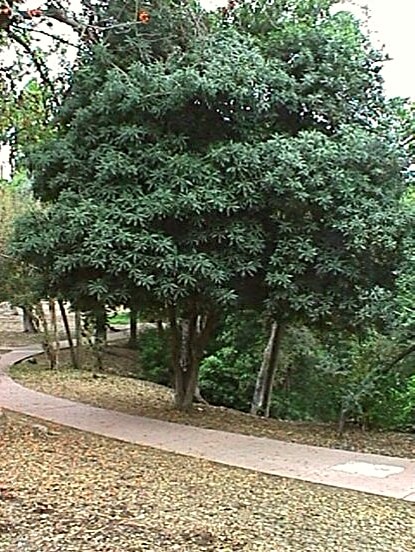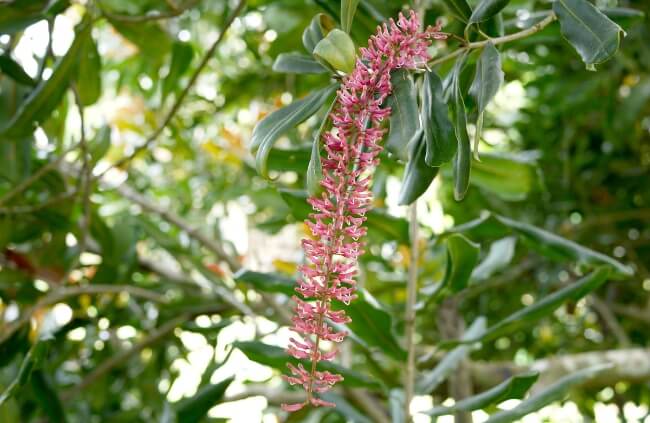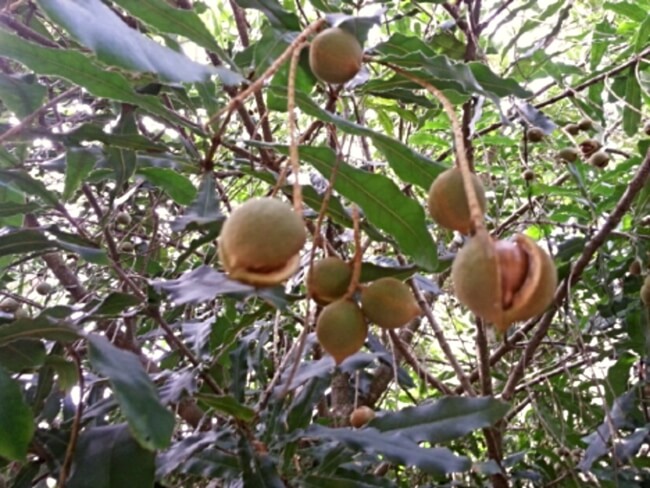There are two edible Macadamia species: Macadamia tetraphylla and Macadamia integrifolia. The former is our focus today, and certainly the one worth shining a light on. While neither are particularly ornamental trees, Macadamia tetraphylla has striking long, dangling racemes that can be found in pinks, yellows, greens and white.
Its riven foliage undulates along the leaf edge, similar to the common houseplant, Croton, but without the complicated colouring. It is, maybe, Australia’s answer to the peach. But, beneath its horticultural usefulness, the Queensland nut stands out from others in its family.
So, get ready to grow your own macadamias, and dive into the details of these fascinating fruit trees.
More...

Source: GardensOnline
Family: | Proteaceae |
|---|---|
Genus: | Macadamia |
Species: | M. tetraphylla |
Common names: | Macadamia nut, Queensland nut, Bauple nut, rough-shelled Queensland nut, rough-shelled bush nut, prickly macadamia. |
Origin: | Australia |
Location: | Outdoor |
Type: | Large trees |
Growth: | 18m tall |
Sun requirements: | Full sun |
Foliage colour: | Green with red tips on new leaves |
Flower colour: | Red/orange pendulous spikes |
Flowering: | Mid-winter (can also be sporadic throughout the year) |
Edible parts: | Edible nuts |
Maintenance level: | Low |
Poisonous for pets: | Macadamia nuts are toxic to dogs and cats |
What is Macadamia tetraphylla?
Macadamia tetraphylla has dozens of common names, but most are variations on the Bauple nut, rough-shelled macadamia, bush nut, Queensland nut, or prickly bush nut. All refer to the same thing – the dimpled, rough, exterior surface of the husk, and inner shell of Macadamia tetraphylla.
Growing to around 18m tall, these rainforest-loving plants thrive with regular rainfall, but excellent drainage, in reliably warm conditions.
Unlike other species in its genus, the flowers are striking enough for these trees to be considered ornamental, but they still tend not to have a place in contemporary garden design, which is a shame, as they are one of the most useful and elegant native edibles we have here in Australia.
Rough-shelled Macadamia's Natural Habitat
Macadamia tetraphylla grows in dry rainforests around northeastern Australia, where it benefits from richly nutritious free-draining soils, but heavy rainfall. Most are found on the borders of rainforests where they can get access to direct sunlight, without competition from taller trees. This also puts them in the ideal spot for the most efficient access to water.
Consider that access to moisture before planting Macadamia tetraphylla, as it relies heavily on its ability to source water almost constantly without becoming waterlogged, in order to produce large, rich, creamy macadamia nuts.
Common Uses for Macadamia tetraphylla
Macadamia’s only common use is as a food crop. It has a limited horticultural history, and there are, admittedly, more attractive alternatives for ornamental gardens.
In terms of historical significance, Macadamia tetraphylla was the first native tree to be cultivated by non-indigenous Australians as a commercial crop. The first plantation dates back to the 1880s, and it was entirely made up of M. tetraphylla, with no sign of M. integrifolia – likely because the seeds just weren’t as sweet.
Seedlings from that plantation are still growing today in commercial macadamia farms, but the plantation itself was cleared in the 1990s.
Identifying Macadamia tetraphylla
Identifying macadamia trees is quite simple if you are foraging. The trees have distinctive leaf formations, and ridged leaf edges, creating a rippled over the reflected pair of leaves, growing alternately up new stems.
Separating Macadamias tetraphylla from the three other species is a little harder, but thankfully, not a dangerous task. ‘Tetraphylla’ means, quite literally, four leaves, referring to the fact that this species is the only one to have four leaves gathered around a single node.
Plus, while only two of the four species are enjoyable, all four are non-toxic. The other two species just have a bitter flavour caused by a chemical called cyanogenic glycosides.
Macadamia tetraphylla Vs Macadamia integrifolia
As plants, there is little to separate Macadamia integrifolia from Macadamia tetraphylla. The former is the most common, because its smooth nuts have lower sugar content, and bake better as a result.
The higher sugar content in Macadamia tetraphylla caused it to catch and caramelise when cooked. But, for lovers of raw macadamias, or macadamia-based creams, pastes or milks, it is that exact trait that makes it one of the most exciting food-producing plants on the planet.
In terms of the physical differences between the plants, there aren’t many, but it's worth noting, for identification purposes, that M. tetraphylla has longer racemes of flowers, and subsequently nuts. Its nuts develop with a bump husk, and even once broken, the shell inside the husk is dimpled and uneven.
The fresh foliage on Macadamia integrifolia has red or russet tips on each leaf, which Macadamia tetraphylla does not.
How to Grow Macadamia tetraphylla
There are three pillars to growing Macadamia tetraphylla. Each is based on a certain element of their native climate, on free-draining soils, enriched with the fallen leaves of a rich canopy of mixed plants.
The result is a diverse forest floor of nutrient-rich and accessible materials, packed full of positive bacteria and minerals. It might seem a steep task to replicate that in our gardens, but that’s precisely what the no-dig gardening method is about – read all about the benefits of no-dig gardening in our guide here.
From seed to harvest, growing macadamias is a rewarding endeavour and one that keeps on giving. Follow our guide to learn everything you need to know about growing these unusually sweet nuts.

Source: Growables
Ideal Conditions for Growing Macadamia tetraphylla
Getting the position right for macadamia trees is essential. Once they’re planted, there’s no moving them. They need space to grow up to maturity, or a rigorous routine of training them into espaliers or fan shapes against walls.
Like smooth-shelled macadamias, these rough-shelled Queensland nuts are quick to establish, generally establishing their full root system after just ten years. They don’t mean they stop growing, but it does mean they are controllable and predictable.
Most importantly, it means that they can be planted near buildings without risk.
Soil & Drainage
Macadamia tetraphylla will grow on most soil types, including heavy clay, light sand and rich loam, as long as it has a neutral or mildly acidic pH and drainage.
Drainage doesn’t need to be exceptional, but they can’t sit in water for too long, especially through winter, as they are susceptible to various fungal causes of root rot and raceme blight.
Throughout summer, keep their roots wet, but keep an eye on drainage too. They should take at least two buckets of water per week, but the soil should dry out almost completely between each drink.
Light & Temperature
They might not be picky about soil, but they sure do have some specific requirements when it comes to sunshine.
Full sun for 8 hours per day is a basic minimum for productive macadamia trees. They can be planted with light shade for a few hours a day, and up north, can even have slightly less of their recommended dose of vitamin D, but the further south you go, the more light they need.
Shelter
For gardens further south, and even in Tasmania, it is possible to grow these more cold-tolerant macadamias outdoors all year round. However, they are not completely frost-hardy, so do require protection from snow or temperatures below 5°C.
In some cases, that will simply mean planting them up against the wall of the house, or fleecing them over winter and pruning them to a manageable height. In others, you will have to grow them in large containers and move them indoors.
For us, it meant planting our macadamia up against a North-facing brick wall, in full sun. The brick holds the heat, and over winter we drape fleece right over the face of the tree, which is pruned hard each year to keep it small. It's an extreme shelter, but it’s worth it.
Planting Macadamia tetraphylla
After preparing the ground, and picking a good spot for your macadamia, the process of planting it requires a touch more planning. These are no ordinary trees, and they are very needy feeders.
Competition from weeds will not only limit nut production, but it will inhibit their establishment too. It might seem extreme, but the smallest ground-cover weeds can have a big impact on macadamia roots while they establish, so dig over the ground, and remove any perennial weeds or unwanted roots from around the planting site.
After that, plant your macadamia tree as you would plant any fruit tree. Dig over a good-sized square hole, at least twice the width of the root ball. The shape of the hole encourages roots to spread out, anchoring the tree sooner.
Place the tree with care. If it is against a wall, offer it a slight lean to reduce strain or any bending of branches later. If it is in an open space, consider its best side. After all, this tree will likely be here for centuries. Then just backfill and firm it in, staking if necessary against high winds.
How to Propagate Macadamia tetraphylla
The traditional commercial method for propagating Macadamia tetraphylla is grafting, which requires a rootstock, but it is also entirely possible to propagate macadamia trees from seeds (the nut) and from cuttings.
The only thing to note, when propagating macadamia trees from seed, is their ability to cross-pollinate with other macadamias, potentially producing unproductive, or badly flavoured nuts.
The frustrating part of this isn’t the misbred tree, it’s the fact you’ll have to wait over a decade to find out, as it can take ten years or more for macadamias grown from seed to produce their first nuts.
Cuttings, therefore, provide a more reliable form of DIY Macadamia tetraphylla propagation.
Propagating Macadamia tetraphylla from Seeds
Fresh macadamia nuts, still in their shell, are much more reliable for germination than store-bought macadamias, but it is actually possible to germinate macadamias grown from grocery store nuts.
They will need soaking before sowing, but that’s helpful for fresh seeds too, so why not give it a go?
- Start by soaking your Macadamia tetraphylla seeds for 48 hours.
- After soaking, place the seeds into a tray of sieved compost or topsoil.
- Store the tray somewhere over 25°C, and away from pests. That could be outdoors if the temperature is warm enough, or indoors on a heated propagator tray.
- Germination usually begins after 48 hours but can be slower.
- Once germinated, plants develop quickly and may need pricking out after two or three weeks into individual pots.
Propagating Macadamia tetraphylla from Cuttings
Macadamia trees are traditionally grafted by growing rootstocks from seed and then adding the cutting of a more vigorous, fruiting, tree to get results faster.
This method works, but taking cuttings is much quicker for beginners, and doesn’t require nearly as much preparation.
To take Macadamia tetraphylla cuttings at home:
- Fill a 10cm pot with a free-draining mix of compost and perlite, moistened slightly, and with holes dibbed down each corner.
- Cut 10-15cm pieces of fresh growth from a healthy, mature, macadamia tree.
- Dip the cutting in rooting gel, and then immediately insert it into the pot.
- Water it in so there is good contact with the soil, and a tight connection with the plastic pot on one side to aid drainage.
- Place your cuttings somewhere warm but out of direct sunlight, and keep them misted and moist until buds start to break open.
Grafting Macadamia tetraphylla
Cuttings are quicker and don’t require any rootstock, but the benefit of the rootstock is that you have a more mature plant, ready to support the more vigorous fruiting growth of older trees.
Taking cuttings stunts the development of that piece of stem, setting it back several years until its roots can support and feed new nuts.
Caring for Macadamia tetraphylla
Queensland nuts don’t really ask for much. A little drink here and there, some manure in spring, and that’s about it. As long as you take notice of their overall condition, and avoid over-watering them, you can’t really go wrong with these delicious native nuts.
But not going wrong, isn’t necessarily right. A tree that survives and one that thrives is going to produce a very different crop, so follow the tips below to get the most out of your mature tree.

Watering mature Macadamia tetraphylla trees
So, your macadamia tree is well established, and it’s started bearing fruit. What now? Well, now, it's time to get your botany book out and remember what rainforest plants need. They need water. And lots, and lots, and lots of it.
Assuming your rough-shelled macadamia is growing well, in a well-drained spot, on reasonably rich soil, it should be drying out regularly between waters. That’s a good thing, but, in summer, when the weather turns and the ground can dry to a crisp, these trees are doing their hardest work, and need as much water as you can give them.
Install a water butt to collect rainwater if you haven’t already got one, and add an extra bucket of water per week around the base of your tree through hot summers or droughts.
Feeding Macadamia tetraphylla
Mulch is the key to the health and production of Macadamia tetraphylla. These trees are hungry, and you can’t go wrong with well-rotted horse manure. But don’t restrict yourself. They need balanced nutrients and lots of them. That can come from all sorts of sources.
Cow manure, rabbit, chicken or sheep manure. It’s all good stuff, and it's all beneficial to the development of Bauple nuts. If you prefer not to mulch, similar effects can be achieved with balanced liquid tomato foods, liquid seaweed or granular fertilisers for native plants.
Pruning Macadamia tetraphylla
Macadamia tetraphylla will grow to 18m tall if given the chance, so regular pruning is essential if you want to keep it manageable, and keep your nuts within reach.
They can be trained as espaliers, fans, or cordons along walls and fences for the most effective harvest methods, but they can, with proper attention, be grown as shorter trees, with goblet-shaped pruning, regularly removing the largest limb.
Pollinating Macadamia tetraphylla
Macadamia tetraphylla is almost completely dependent on bees for pollination, and without pollination, you won’t get any nuts at all.
In most cases, it is an instinctive and natural thing for bees to turn up to flowering macadamia trees. But bees are in decline in suburban settings, so it's important to do everything you can to attract them in. That might mean installing a bug hotel, or a bee box, but it can be even simpler.
Just planting pollinator-friendly plants and letting sections of lawn grow longer does wonders for bringing them into your garden.
Harvesting Macadamia Nuts
Having spent all that time working towards a bumper crop of macadamia nuts, there isn’t much else you can do but wait for them to ripen, which usually takes about 8 months from flowering.
Knowing When Macadamia Nuts are Ready to Harvest
Macadamia tetraphylla has a short harvest season that lasts for just over eight weeks, usually from mid-May onwards. Red varieties tend to have even shorter harvest windows, perhaps due to having flowers that are more attractive to pollinators and are therefore pollinated in a shorter timeframe.
Regardless, the early signs that your nuts are ready for harvest will be that they begin to drop from the tree. They do not become overripe before dropping, so can be harvested before or after they fall.
Harvesting them while they are still on the tree is unreliable, and they do not ripen after being removed, so it is best to let them fall naturally.
How to Store Macadamia Nuts
After harvesting, Macadamia tetraphylla has a short storage window. They can be frozen for about 6 months at most before their texture fails and they start to taste stale. They keep in the fridge for around three months, or in a dry, air-tight, container for about the same amount of time.
Common Macadamia tetraphylla Problems
Raceme blight is the most problematic fungal problem afforded to Macadamia tetraphylla, but there are several other fungal issues that are shared between these fruiting trees and many other soft-stemmed veggies you grow around the garden.
In addition to the usual fungal issues, there are some regular visitors that you’ll need to look out for, to stop them from getting your crop before you do.
Macadamia tetraphylla Pests
Everything from stink bugs to rats will go for Macadamia tetraphylla. While most pests are attracted to the nuts (some use them as a home, and others as a food), there are a few that just seem to love the protection of the usually undistributed foliage.
Most foliage pests and sapsuckers can be left alone with mature macadamia trees so, below, we’ll focus on those that can be dealt with.
Rats
Rats are a simple pest to prevent. They don’t like it when things are tidy and require a steady supply of fatty foods to keep them interested.
While they might still take you by surprise, it's always worth keeping a note of when your nuts are likely to start dropping. The sooner you get them off the floor, the less chance you’ll have of rats beating you to it.
Spiders in Macadamia Orchards
Spiders aren’t damaging to macadamia harvests, but they can pose a risk to you while you go about harvesting them. Because macadamias are only accessible foods to a handful of birds, when they are planted in large numbers for commercial harvests, or even domestic orchards, they tend to become safe havens for insects that would otherwise be bird food.
Try to keep a variety of plant species together, even if it means leaving gaps in plantations.
Nut Borers
Macadamia nut borers tell you everything you need to know from their name. They bore into macadamia nuts, and completely ruin them. The nuts can be filled with larvae by the time you get to them and will have fallen from the tree, unripe, and partially eaten.
If you notice unripe nuts falling early, gather them and dispose of them, either by burning or in your regular trash.
Macadamia tetraphylla diseases
Macadamia tetraphylla is not as resilient as other natives against fire. Along with other Macadamia species, it requires loose soil to thrive. Soil compaction is harmful to their root systems, and can cause once free-draining soil to become waterlogged.
Most of the diseases below are caused by just that problem – overwatering and waterlogging.
Anthracnose
Anthracnose is an incredibly common plant disease, causing leaf spot across foliage, and similar markings over the husks of nuts themselves. The markings are brown with black rings around them and can join up to form oddly shaped lesions.
To prevent anthracnose spreading, remove any signs of the problem and burn them. To prevent it in the first place make sure your soil is draining properly, and avoid wetting the foliage. Always use clean tools, and manually remove leaf pests when you see them.
Husk spot
Pseudocercospora macadamiae is a very special fungal pathogen that causes pale orange spots, or patches, on the outer husk of macadamia nuts.
The fungus lives in old, dried-up nuts that have not fallen from the tree and passes to new developing nuts when rain splashes or insects move between them.
The only way to prevent the recurrence of this is to continually remove any dead or dried nuts from the tree each year.
Raceme blight
Botrytis cinerea, better known as raceme blight, is a fungal problem that causes flowers to blacken and die. It drastically affects Macadamia tetraphylla when it strikes, and is worst during warm rainy seasons.
There isn’t much you can do to fix the problem once you see it, but removing the fallen racemes and cutting out the damaged ones in the tree will help to slow the spread.
With good attention to hygiene, and regularly removing damaged racemes, you can prevent the blight from returning next year.
Slow and quick tree decline
Xylaria arbuscula is a root fungus that causes something called ‘quick tree decline’. The problem is caused when the fungus comes into contact with damaged parts of the tree. This is usually branches or trunks rather than foliage. The result is rapid browning of the section of the tree beyond the infected point.
‘Slow tree decline’ is caused by a root fungus. Foliage will become yellow, usually on one side of the tree, and fade in vigour over several months. The problem is hard to rectify but fast action around improving drainage can help.
Macadamia tetraphylla Frequently Asked Questions

Source: ResearchGate
How big does Macadamia tetraphylla get?
Macadamia tetraphylla reaches a mature height of 10m tall in most settings but can grow to 18m if given competition. For the best and most manageable results, plant rough-shelled macadamia in open ground.
Is Macadamia tetraphylla a messy tree?
Macadamia tetraphylla can be a messy tree, due to flower drop and the expected dropping of husks when they are ready to harvest. Without regular harvesting, there will be a lot of flower and husk litter. For the tidy gardener, it’s a problem, for the resourceful gardener, it’s a bonus.
What is the common name for Macadamia tetraphylla?
Macadamia tetraphylla has more common names than we have time to go over, but its most famous is the Queensland nut and the rough-shelled macadamia. Rough-shelled macadamia is its most popular global name as it is the simplest description of its fruit.
Can you eat a Macadamia tetraphylla straight from the tree?
You can eat Macadamia tetraphylla straight from the tree. The nuts are sweeter than Macadamia integrifolia, and therefore even better eaten raw. In fact, they are better eaten raw than cooked.
Is Macadamia tetraphylla toxic to pets?
Macadamia is toxic to dogs, and potentially hazardous to cats which are more likely to have nut allergies.
What is the best spacing for Macadamia tetraphylla?
Space Macadamia tetraphylla at least 10m away from buildings, and around 8m away from other macadamia trees. If there is open ground in front of it, M. tetraphylla can be grown near a wall.
Does Macadamia tetraphylla have invasive roots?
Macadamia tetraphylla does not have invasive roots, but like all trees, it will lift paving and can grow through old mortar if planted too close to structures.
Immerse Your Garden in the Beauty of Macadamia tetraphylla
Macadamia tetraphylla isn’t the most famous tree in the world and is generally overlooked for its smooth-shelled cousin, Macadamia integrifolia, but we love it, and wouldn’t be without it. The sweet nuts are simply divine, and despite the long wait for our first harvest, it was, and remains, utterly worth it.
If you’d like to grow your own, at home, or would even consider a more ambitious macadamia orchard, then I hope we’ve been able to share some handy tips that steer you in the right direction and get you growing Macadamia tetraphylla with a touch more confidence.
Published on February 6, 2024 by Gary Clarke
Last Updated on March 4, 2024




